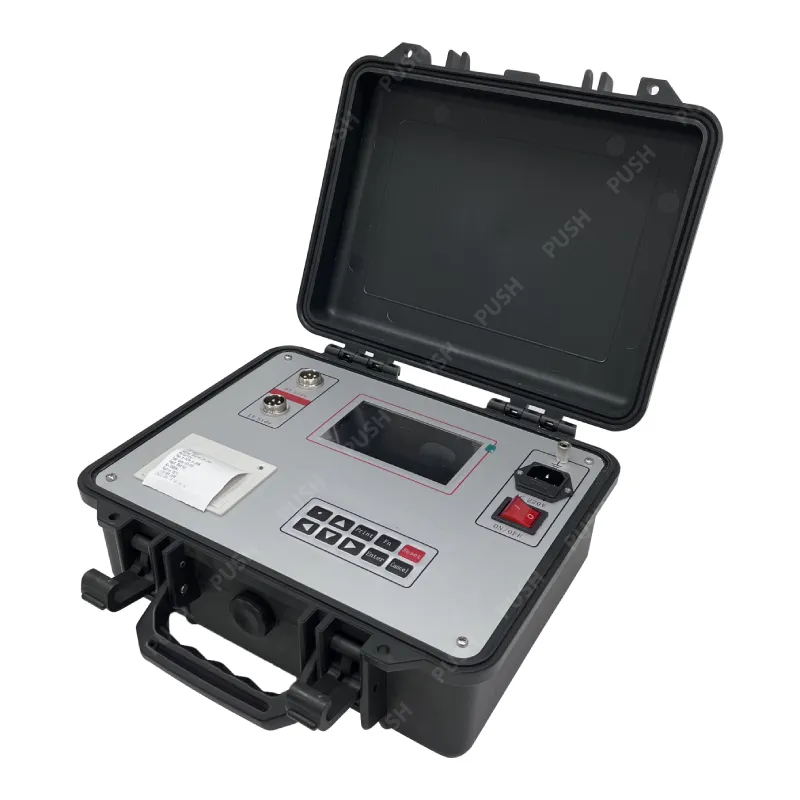TEL:
+86-0312-3189593
 English
English

Telephone:0312-3189593

Email:sales@oil-tester.com
7 月 . 11, 2024 06:10
Back to list
Measurement of capacitance and tan delta for accurate analysis of electrical properties.
Capacitance and tan delta measurement are essential techniques used in the field of electrical engineering to assess the quality and performance of electrical insulation systems. These measurements provide valuable information about the dielectric properties of materials, which are crucial in determining their suitability for use in various applications.
Capacitance is a measure of the ability of a material to store electrical energy when subjected to an electric field. It is determined by the geometry of the material and the dielectric constant of the material. Different materials have different capacitance values, with higher values indicating better electrical insulation properties. By measuring the capacitance of a material, engineers can assess its dielectric strength and reliability in electrical applications.
Tan delta, also known as the loss angle or dissipation factor, is a measure of the energy lost as heat when an alternating current (AC) voltage is applied to a material. It is expressed as the ratio of the dissipated power to the stored energy in the material. A low tan delta value indicates that the material has low losses and is therefore a good insulator. High tan delta values, on the other hand, indicate that the material is not suitable for use in high voltage applications due to the high heat generated during operation

capacitance and tan delta measurement. The capacitance and tan delta measurements are typically performed using specialized equipment such as a dielectric analyzer or a power factor test set. These instruments apply an AC voltage to the material under test and measure the response in terms of capacitance and tan delta. By analyzing the results of these measurements, engineers can determine the quality of the insulation system and identify any potential issues that may affect its performance. In the field of electrical engineering, capacitance and tan delta measurements are commonly used to assess the condition of insulation systems in transformers, cables, motors, and other electrical equipment. By regularly monitoring these parameters, engineers can identify any degradation in the insulation material and take corrective actions to prevent equipment failures and ensure the reliability of the electrical system. In conclusion, capacitance and tan delta measurements are vital tools in evaluating the dielectric properties of materials and assessing the quality of insulation systems. By measuring these parameters, engineers can determine the suitability of materials for use in electrical applications, identify potential issues that may affect performance, and ensure the reliability of electrical equipment. As technology advances, the importance of capacitance and tan delta measurements will only continue to grow, making them indispensable techniques in the field of electrical engineering.

capacitance and tan delta measurement. The capacitance and tan delta measurements are typically performed using specialized equipment such as a dielectric analyzer or a power factor test set. These instruments apply an AC voltage to the material under test and measure the response in terms of capacitance and tan delta. By analyzing the results of these measurements, engineers can determine the quality of the insulation system and identify any potential issues that may affect its performance. In the field of electrical engineering, capacitance and tan delta measurements are commonly used to assess the condition of insulation systems in transformers, cables, motors, and other electrical equipment. By regularly monitoring these parameters, engineers can identify any degradation in the insulation material and take corrective actions to prevent equipment failures and ensure the reliability of the electrical system. In conclusion, capacitance and tan delta measurements are vital tools in evaluating the dielectric properties of materials and assessing the quality of insulation systems. By measuring these parameters, engineers can determine the suitability of materials for use in electrical applications, identify potential issues that may affect performance, and ensure the reliability of electrical equipment. As technology advances, the importance of capacitance and tan delta measurements will only continue to grow, making them indispensable techniques in the field of electrical engineering.
Previous:
Latest news
-
Differences between open cup flash point tester and closed cup flash point testerNewsOct.31,2024
-
The Reliable Load Tap ChangerNewsOct.23,2024
-
The Essential Guide to Hipot TestersNewsOct.23,2024
-
The Digital Insulation TesterNewsOct.23,2024
-
The Best Earth Loop Impedance Tester for SaleNewsOct.23,2024
-
Tan Delta Tester--The Essential Tool for Electrical Insulation TestingNewsOct.23,2024





